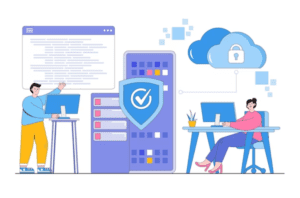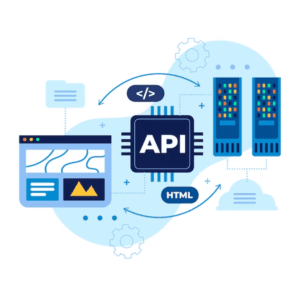Serverless Security and Security Computing
Many cloud providers now offer secure cloud services using special security tools or structures. According to LogicMonitor, there might be a decrease of 10% to 27% in on-premises applications by 2020. However, cloud-based serverless applications like Microsoft Azure, AWS Lambda, and Google Cloud are expected to grow by 41%. The shift from in-house systems to serverless cloud computing has been a popular trend in technology.

Security risks will always exist no matter how well a program or online application is made. It doesn’t matter how securely it stores crucial information. You’re in the right place if you’re using a serverless system or interested in learning how to keep serverless cloud computing safe.
What is Serverless Computing?
The idea of serverless computing is about making things easier for application developers. Instead of managing servers, they can just focus on writing and deploying their code as functions. This kind of cloud computing called Function-as-a-Service (FaaS), removes the need for programmers to deal with the complicated server stuff. They can simply concentrate on their code without worrying about the technical details of building and deploying it.
In serverless architectures, the cloud provider handles setting up, taking care of, and adjusting the server infrastructure according to the code’s needs. Once the applications are deployed, they can automatically grow or shrink depending on how much they’re needed. Organizations can use special tools and techniques called DevOps automation to make delivering software faster, cheaper, and better. Many organizations also use tools like Docker and Kubernetes to automate their DevOps tasks. It’s all about making things easier and smoother.
Software designed specifically for managing and coordinating containers and their contents is called container management software.
In serverless models, organizations can concentrate on what they’re good at without considering the technical stuff in the background. But it’s important to remember that some security things still need attention and care. Safety is always essential, even when things seem more straightforward. Here are some reasons why you need to protect your serverless architecture or model:
- In the serverless paradigm, detection system software (IDS tools) and firewalls are not used.
- The design does not feature any protection techniques or instrumentation agents, such as protocols for file transmission or critical authentication.
Even if serverless architecture is even more compact than microservices, organizations still need to take measures to protect their systems.
What Is Serverless Security?
In the past, many applications had problems with security. Criminals could do things like to steal sensitive information or cause trouble with the code. To stop these problems, people used special tools like firewalls and intrusion prevention systems.
But with serverless architecture, those tools might work better. Instead, serverless uses different techniques to keep things safe, like protecting the code and giving permissions. Developers can add extra protection to their applications to ensure everything stays secure. It’s all about following the proper rules to keep things safe.
This way, developers have more control and can prevent security problems. Using container management software can make serverless applications even more secure.

Best Practices for Serverless Security
1. Use API Gateways as Security Buffers
To keep serverless applications safe, you can use unique gateways that protect against data problems. These gateways act like a shield, keeping the applications secure when getting data from different places. Another way to make things even safer is using a unique reverse proxy tool. It adds extra protection and makes it harder for bad people to cause trouble.

As part of DevOps automation practices, it is essential to leverage the security benefits provided by HTTP endpoints. HTTP endpoints offer built-in security protocols that encrypt data and manage keys. To protect data during software development and deployment, use DevOps automation and secure HTTP endpoints.
2. Data Separation and Secure Configurations
Preventative measures against DoW attacks include:
- Code scanning.
- Isolating commands and queries.
- Discovering exposed secret keys or unlinked triggers.
- Implementing those measures by the CSP’s recommended practices for serverless apps.
It is also essential to reduce function timeouts to a minimum to prevent execution calls from being stalled by denial-of-service (DoS) attacks.
3. Dealing with Insecure Authentication
Multiple specialized access control and authentication services should be implemented to reduce the danger of corrupted authentication. The CSP’s Access control options include OAuth, OIDC, SAML, OpenID Connect, and multi-factor authentication (MFA) to make authentication more challenging to overcome. In addition, you may make it difficult for hackers to break your passwords by enforcing individualized regulations and criteria for the length and complexity of your passwords. Boosting password security is critical, and one way to achieve this is by using continuous management software that enforces unique restrictions and requirements for password length and complexity.
4. Serverless Monitoring/Logging
Using a unique technology to see what’s happening inside your serverless application is essential. There could be risks if you only rely on the cloud provider’s logging and monitoring features. The information about how your application works might be exposed, which could be better. It could be a way for bad people to attack your application. So, having a sound monitoring system is essential to keep an eye on things and stay safe.
5. Minimize Privileges
To keep things safe, it’s a good idea to separate functions and control what they can do using IAM roles. This means giving each position only the permissions it needs to do its job. By doing this, we can ensure that programs only have the access they need and reduce the chances of any problems happening.
6. Independent Application Development Configuration
To ensure continuous software development, integration, and deployment (CI/CD), developers can divide the process into stages: staging, development, and production. By doing this, they can prioritize effective vulnerability management at every step before moving on to the next version of the code. This approach helps developers stay ahead of attackers by patching vulnerabilities, protecting updates, and continuously testing and improving the program.
Effective continuous deployment software practices contribute to a streamlined and secure software development lifecycle.
Conclusion
Serverless architecture is a new way of developing applications. It has its benefits and challenges. But it also brings some significant advantages, like making it easier to handle infrastructure, being more productive, and scaling things efficiently. However, it’s essential to be careful when managing the application’s infrastructure. It is because this approach focuses more on improving the infrastructure than just writing good code. So, we must pay attention to both aspects to make things work smoothly.
When we want to keep serverless applications safe, we must be careful and do things correctly. The good thing is that cloud providers now have perfect security features, mainly because more and more businesses are using serverless architecture. It’s all about being smart and using our great security options. Organizations can enhance their serverless security practices by combining the power of DevOps automation and continuous deployment software.
Experience the next level of cloud security with Nife! Contact us today to explore our offerings and fortify your cloud infrastructure with Nife.






